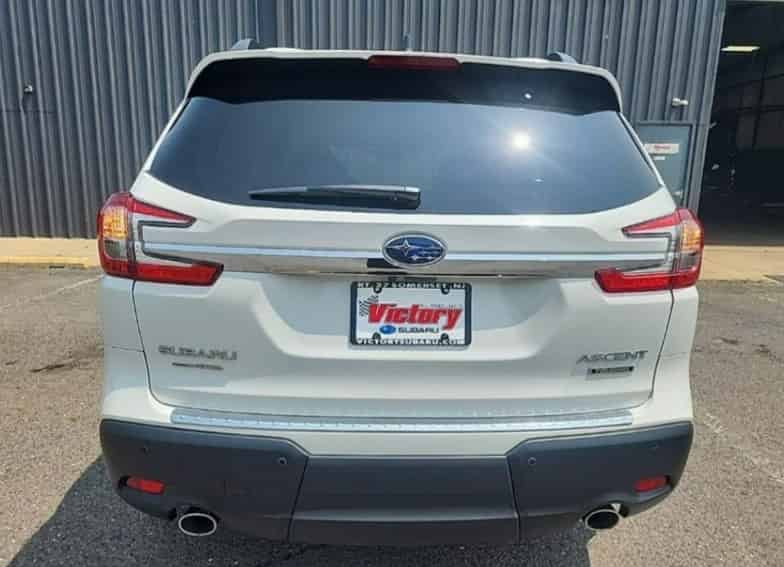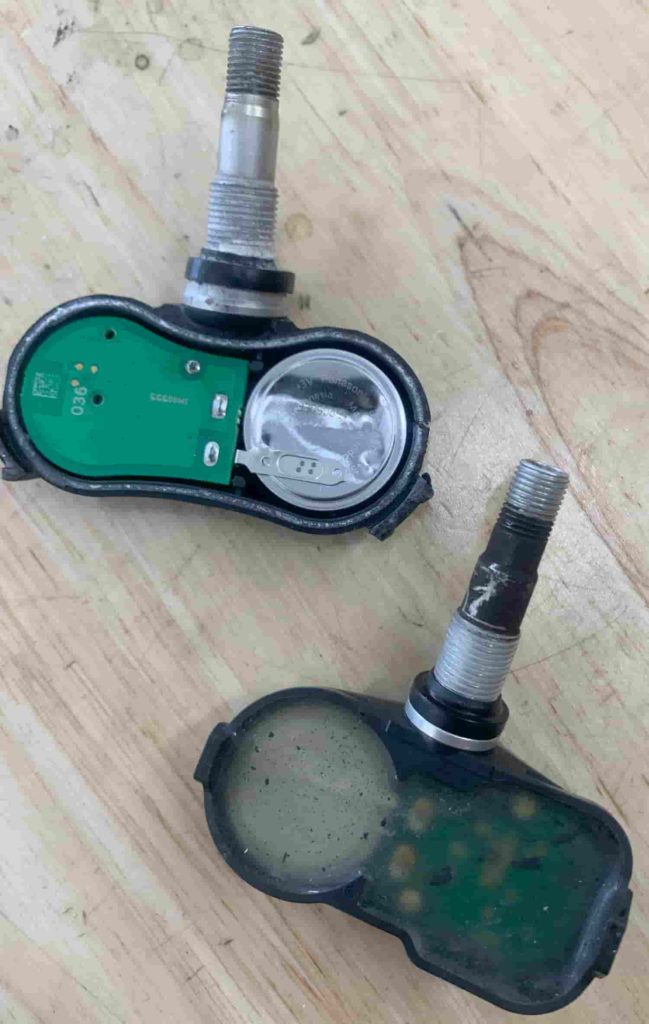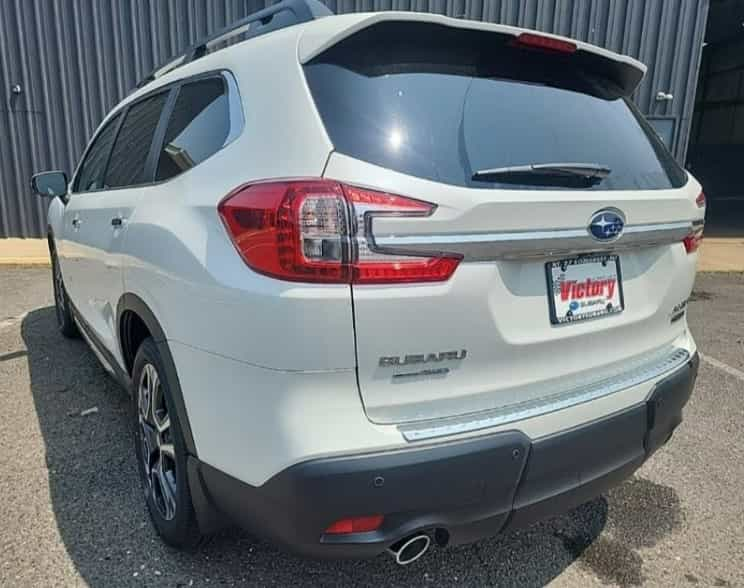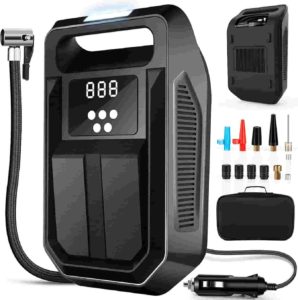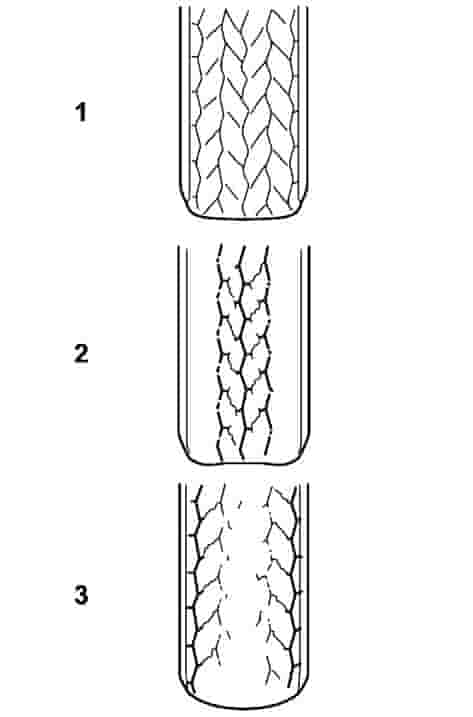Introduction
Before diving into the details, it’s important for you to know that your Subaru Ascent does not have a button to reset your tire pressure light. We explain how your tire pressure monitoring system works, steps to reset and turn off your tire light and how to diagnose TPMS problems.
What is the TPMS in the Subaru Ascent?
The tire pressure monitoring system (TPMS) in a Subaru Ascent is an integral safety feature designed to maintain optimal tire performance and road grip. The system oversees the pressure in all four tires, alerting the driver via a warning indicator on the vehicle’s dashboard if any tire’s pressure deviates significantly from the recommended level. This system exists to enhance the vehicle’s overall safety. To check your current tire pressure: Find the 3 buttons “i/Set” with the up and down arrow on the bottom left of your steering wheel. Use the top or bottom arrow to scroll through a list of screens until you see the tire pressure screen.
How to Reset the Subaru Ascent Tire Pressure Light
The Subaru Ascent does not have a tire pressure reset button.
When the tire pressure light on your dashboard turns on, pull over slowly and check your tire pressure right away.
Figure out which tire is low or high on air and adjust the tire pressure accordingly. (The TPMS lets you know which tire is low on your screen by displaying the low pressure value in yellow instead of white)
Fill your tires to the exact recommended pressures. I cannot emphasize this enough, accuracy is key.
Drive your Subaru Ascent. Drive for 10 or 15 minutes at speeds over 20 Mph. This will reset the tire light.
If the light doesn’t go off right away, re-check your tire pressure to make sure they are all at the exact pressure you set them to. If they are down in pressure, you probably have some sort of tire leak.
What Tools Do You Need to Reset the Subaru Ascent TPMS?
All you require to reset the tire pressure light in the Subaru Ascent is a reliable air pressure gauge. The reset process is integrated within the vehicle’s Engine Control Unit (ECU) of the Subaru Ascent.
Tire Leaks and Solutions
Is it Safe to Drive With the Tire Light On?
It’s strongly recommended not to drive your Subaru when the tire pressure warning light is on, as it could pose a risk to your safety. It’s vital to identify the actual cause of the problem. Could your tire be punctured by a foreign object like a nail or screw? Is there a leak in the bead seal? Is the tire deflating rapidly or slowly? Only by accurately determining the underlying issue can you assess whether it’s genuinely safe to drive with the tire warning light on, and if so, how long it would be safe to do so. Hence, keeping a portable tire inflator handy in your vehicle is a smart safety measure.
How To Find the Source of a Tire Leak?
To find the source of a tire leak, start by checking the air pressure in each tire to single out the underinflated one. Inflate the identified tire as this technique won’t work if the tire is entirely devoid of air. Create a mixture of water and soap (or Windex) in a spray bottle and generously spray it all over the tire. Pay special attention to the bead seal(the area where the tire meets the wheel’s rim) and the valve stem. Ensure that the tire’s entire surface is drenched. After waiting for a short while carefully look for any small bubbles forming on both the outer and inner surfaces of the tire. If the tire is leaking the escaping air will form tiny bubbles at the leak site when it interacts with the soap solution. Find the bubbles and you’ve found the leak!
Are Tire Plugs Safe?
Indeed! Drawing from my personal experience of using tire plugs to mend hundreds of tires, I can vouch for their reliability without a doubt. Tire plugs provide an effective solution for punctures occurring in the tread area of the tire. They are made of durable, rubber-like materials that can endure the demanding conditions within a tire, including significant fluctuations in air pressure and temperature. If installed properly, a tire plug can last for the tire’s remaining lifespan. Keep in mind that tire plugs are not meant to repair the tire’s sidewall.
Why is My Tire Light On But My Tires are Fine?
Your tire pressure warning light might illuminate for a few reasons, even if your tires seem perfectly okay. Firstly, even if the tires appear alright, their pressure might not be. Verify the pressure of all four tires including the spare to ensure they are at the correct level. If all pressures are fine, consider other factors. Has there been a significant weather shift recently? Does the tire light turn off after inflating but reappear once you start driving? If so, your tire may have a leak. If the tires maintain the recommended pressures without losing air and the tire light persists, you likely have a malfunctioning tire pressure sensor due to a depleted battery (TPMS fault).
What Else Can You Try to Turn Off the Tire Light?
If the tire pressures are at the exact pressure you set them to and the tire light still won’t go off, over fill your tires. We recommend filling your problem tire with 45 Psi or about 10 Psi over the recommended pressure. Sometimes this can wake up a sleeping sensor. With the tire overfilled, drive the car again for another 10 or 15 minutes. This will turn off the tire light. Now that the tire light is off, readjust the pressure back to the recommended Psi. Another option, if you followed all these steps and the light is still on, check your spare tire. Some Subaru Ascents (depending on the package you have) have a full size spare with a pressure sensor in them. Make sure your spare tire has the correct Psi. Now drive the car again. The last and final option to try is disconnecting the main 12 volt battery. Disconnect the negative terminal for a few minutes and then reconnect it. This will erase all store error codes in the Subaru Ascents computer including the tire pressure light error code.
How Does the Subaru Ascent TPMS Work?
The tire pressure monitoring system (TPMS) in the Subaru Ascent uses an intricate system of sensors and software to monitor and maintain the optimal tire pressure for your vehicle. Here’s a more in-depth explanation of how it all works:
Sensors: Each tire, including the spare in some models, is equipped with a pressure sensor that is part of the valve stem. These sensors are battery-powered and their main purpose is to monitor the air pressure inside the tires. They work by measuring the air pressure and converting it into an electrical signal.
Transmitter: Once the sensor measures the pressure, this information is sent to a transmitter that is integrated into the sensor assembly. The transmitter then sends a radio frequency signal containing the pressure information and unique sensor ID to the TPMS control module.
TPMS Control Module: This is the “brain” of the system, located within the vehicle. (usually behind the dashboard or glove box) It receives the data sent from each of the tire pressure sensors. The module reads the pressure information, sensor ID and even sensor battery status from each tire and analyzes it.
Dashboard Indicator: If the pressure in any of the tires drops below a certain threshold (usually 15% – 25% below the recommended level), the TPMS control module will trigger a warning (exclamation mark inside a tire symbol) on the vehicle’s dashboard, alerting the driver that their tire pressure is too low. The Subaru Ascent also indicates which tire is underinflated on its data display.
System Self-check: Every time you start driving your Subaru Ascent it performs a self-check, ensuring that the system is functioning correctly and all sensors are communicating properly.
Tire Pressure Sensor Batteries
The tire pressure sensor in each tire has a battery inside that gives it power. It’s crucial to understand that these batteries cannot be changed or charged. They are similar to wrist watch batteries and are fixed directly onto the sensor’s circuit board inside a plastic case. When the battery runs out, you need to replace the entire sensor. The battery’s lifespan can differ depending on factors like driving habits and weather conditions. Typically, tire pressure sensor batteries last between 5 and 10 years.
What Can Cause the Tire Pressure Light to turn On?
Seasonal temperature changes: A drop in ambient temperature can cause tire pressure to decrease, triggering the warning light.
Tire puncture or leak: A sharp object or road debris like a nail or screw may puncture a tire, causing air loss which will of course activate the warning light.
Faulty tire pressure sensor: Damaged or malfunctioning sensors may provide inaccurate readings, resulting in a false alert. The only way to determine which sensor is faulty is to scan each sensor with a TPMS diagnostic tool.
Spare Tire: Driving with the spare tire or donut on your Ascent will make your tire light turn on.
Valve stem issues: A damaged or leaking valve stem can lead to gradual pressure loss and eventual activation of the tire pressure light. They make kits to replace the rubber gasket that usually goes bad.
Tire damage: Impact from potholes or hitting a curb can cause structural damage like tire bubbles, leading to pressure loss.
Sensor battery life: TPMS sensors are battery-powered, and over time, batteries die. (they usually last anywhere from 5-10 years) This will cause the tire pressure light to turn on. Again, you must use a diagnostic tool to determine which sensor is dead or dying.
Recent tire rotation or replacement: If the tires have been recently rotated or replaced, the TPMS may need recalibration to avoid false alerts. Sometimes the vehicle’s computer may think the front tires are in the rear and rear in the front after a rotation.
Wheel or rim issues: Damaged, corroded, or cracked wheels or rims can lead to air leaks and pressure loss. This is very common with low profile tires.
Altitude changes: Climbing or descending in elevation can affect tire pressure and trigger the TPMS warning. An additional 1.5 Psi per Km above sea level is required.
Natural pressure loss: Tires lose air pressure over time due to temperature changes and permeation. Tire dry-rot will happen to tires that sit.
Electrical problems or software issues within the car’s TPMS system. Occasionally the system may have a software update from Subaru.
Snow Tires: If you have a separate set of wheels/rims for snow tires, either swap over the sensors from your summer wheels or purchase a second set of 4 sensors for the second set of wheels/rims. If you are using one set of wheels for both sets of tires, do not worry about this.
Why is the Tire Light Flashing?
The Subaru Ascent’s tire pressure monitoring system also has a malfunction indicator to alert you when something is wrong with the system itself. This indicator uses the same yellow exclamation point as the low tire pressure light. The difference is that, if there is a problem with the system, the light will flash for approximately 60 seconds before staying on. This flashing or blinking will happen every time you start your car until the issue is resolved. When your tire light is flashing your Ascent won’t know if your tires are low on pressure. Basically, a blinking tire pressure light means there is a malfunction within the TPMS itself, rather than an air pressure issue. This is usually due to a faulty pressure sensor in one of your tires (a dead battery) or driving with the spare tire. (if the spare doesn’t have a sensor in it) To determine which sensor is faulty, use a TPMS diagnostic tool and scan each sensor for diagnostic information.
What Happens When Tires are Underinflated?
Underinflation of tires in a Subaru Ascent can lead to a variety of negative consequences, including:
Decreased Fuel Efficiency: Underinflated tires have a larger surface area in contact with the road, increasing rolling resistance. This means your Subaru Ascent has to work harder to move, burning more fuel in the process and reducing your vehicle’s miles per gallon (MPG).
Reduced Handling: Tires that are underinflated can negatively impact the handling and stability of your Subaru Ascent. This could make the vehicle harder to control, especially in poor weather conditions or during abrupt maneuvers, increasing the risk of accidents.
Increased Tire Wear: Underinflation causes tires to wear unevenly, especially along the outer edges, leading to premature tire replacement.
Overheating of Tires: Underinflated tires will cause excessive heat build-up due to increased friction with the road. This heat can degrade the tire’s internal structure, potentially leading to a blowout.
Increased Braking Distance: Underinflated tires will increase your vehicle’s stopping distance as the decreased pressure prevents the tires from gripping the road properly. This could result in longer braking times, which might be problematic in an emergency. It can also result in your brake pads and rotors wearing out faster.
Damage to Vehicle’s Suspension: Driving with underinflated tires can put more stress on the vehicle’s suspension system as it tries to compensate for the lack of tire pressure, potentially causing premature wear or damage.
How Does the Weather Affect Tire Pressure?
Weather plays a key role in tire pressure changes. As a rule of thumb, for every 10-degree drop in temperature, your tires can lose about 1-2 pounds of pressure. That’s because cold air is denser, causing tire pressure to decrease. Conversely, warm weather can cause the air in your tires to expand, leading to increased pressure. So, be it a heatwave or a cold snap, always remember your tire pressure will change with the weather!
How to Check and Adjust Tire Pressure?
Get a high-quality tire gauge.
Make sure to check the tire pressure when the tires are cold. “Cold” means your vehicle has been sitting for at least three hours or driven less than 1 mile in the past 3 hours.
Take off the valve cap from the tire valve stem.
Push the tire gauge firmly onto the valve to measure the pressure.
Compare the pressure reading with the recommended pressure on the tire information label.
If the pressure is lower than the recommended pressure, add air.
If the pressure is too high, let out some air by pressing the metal stem in the center of the tire valve. You can use any object like a screwdriver to do this. Be gentle.
Recheck the tire pressure with the gauge.
Don’t forget to put the valve caps back on to prevent leaks and keep dirt and moisture out.
2023 Subaru Ascent Tire Pressure & Size
TIRE SIZE | FRONT PSI | REAR PSI |
245/50R20 | 33 | 33 |
245/60R18 | 35 | 35 |
SPARE TIRE | 60 | 60 |
When Should you Adjust Your tire Pressure?
To get an accurate pressure reading on your Subaru Ascent, check it when the car has been sitting for a while, like in the morning. (we recommend 3 hours of your car being parked should do the trick) Driving heats up the tires and makes the air inside expand, giving a false high reading. So, don’t change the tire pressure after you’ve been driving, or you will end up with too much air in them.
TPMS Legal Considerations
Is it a Legal Requirement to Have TPMS Sensors?
In many areas worldwide including the United States and Europe, it’s legally required for vehicles to be equipped with Tire Pressure Monitoring System (TPMS) sensors. The TREAD Act, enacted in the U.S. in 2000 mandates that all vehicles manufactured after September 2007 have a TPMS installed. This regulation is mainly aimed at manufacturers rather than motorists to promote road safety by alerting drivers to significant variations in tire pressure. European directives from November 2012 stipulate that all new passenger vehicles be fitted with a TPMS. The key objective of these regulations is to reduce accidents caused by tire failures.
Will My Subaru Pass State Inspection With the Tire Pressure Light On?
Yes. In some states during a vehicle’s safety inspection the tire pressure monitoring system (TPMS) is inspected, but the exact stipulations can differ. For example in New York and Texas the tire pressure light is considered during the state inspection procedure, yet it does not constitute a failing condition. As a licensed New Jersey state inspector I can confirm that a working TPMS is not mandatory in New Jersey for passenger vehicles to pass state inspection. This means a vehicle will pass the state inspection even if the tire pressure light is on. However, for commercial vehicles it’s a different situation as they still need “safety inspections”. Given the variation in regulations across states it is advisable to consult your local Department of Motor Vehicles or other relevant state agencies for the most accurate and current information.
Please note that this blog post contains Amazon affiliate links. This means that if you make a purchase through one of these links, we at TPMSRESET.com may earn a small commission at no extra cost to you. We only recommend products that we personally use and believe in. Thank you for supporting us.



